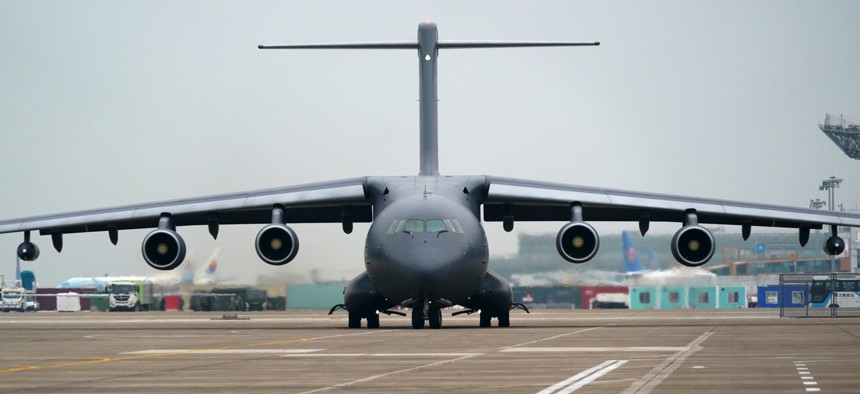THOMAS CORBETT and PETER W. SINGER

The U.S. Air Force has been open about its hunt for more bases and new missile defenses in the Pacific, which reflects the assumption that the region’s scarce runways would be among the first items targeted in a conflict with China. Less is heard about similar efforts by the People’s Liberation Army, which has the very same problem of how to ensure that its own aircraft have places to fly and fight from.
A new report from BluePath Labs reveals how the PLA has been investing heavily in the ability to get its own airfields back up and running following a strike.
Generally, runway repair starts with explosive ordnance disposal. After an enemy attack, any unexploded bombs or missiles on the airfield could be accidentally triggered by subsequent repair operations, which would produce more casualties and set back attempts to restore flight capability. The crucial work of clearing a field is carried out by specialized engineering technical service groups. In exercises, the PLA says, these teams have been able to find and detonate unexploded ordnance in as little as 23 minutes.
The next step is to fill the craters left by the attack. This is typically done by airfield services companies, who start by marking off the affected area, cutting away the edges with a circular saw, breaking up bigger sections with a pneumatic drill, removing the broken pieces, and filling the hole with concrete. The PLA’s adoption of a new kind of quick-drying concrete in 2013 increased the speed at which craters could be filled, with the fastest time for the procedure sitting at 25 minutes and 3 seconds during a competition..
These sorts of competitions are used to hone repair techniques. One source described a PLAAF competition in which units raced to repair two 2.5-foot holes: “The runway cutting was completed in 10 minutes, the pneumatic drilling took 30 minutes, mixing the concrete was completed in 8 minutes, filling was completed in 2 minutes, and the surface was completed in 1 minute, after 25 minutes the repair material was initially set, and after another 2 hours the concrete finally solidified completely for airfield use.”
These times may suggest an impressive capability, but it is important to note that they were all recorded under ideal conditions. Although it has made progress, PLA training still suffers from a lack of realism, and its runway repair drills appear to be no exception. Supplies and vehicles are pre-positioned along the runway, and in some cases PLA personnel literally line up at a starting line and wait for a starting signal to begin. This obviously does not mirror the actual circumstances of a wartime repair job.
Much like the U.S. military, the PLA is also experimenting with alternative basing methods in case an airfield can’t be restored in time. PLA Army Aviation appears to focus on establishing ad-hoc aviation support points for its helicopters, unmanned aerial vehicles, and logistical support aircraft. For example, after one joint strike training exercise, a helicopter brigade landed at pre-established remote and dispersed helipads with refueling and refitting capabilities. A temporary base, established with civilian militia support, can sustain between three and ten helicopters at a time. According to the brigade’s chief of staff, this method is being explored because previously the brigade had to make multiple trips to and from their training bases for their supply needs, slowing the exercises and lowering overall efficiency.
PLA Army Aviation is also training for more difficult situations that may come up during a Taiwan conflict. For example, one brigade organized a training operation in which nearly a dozen helicopters practiced flying to an island and landing in a field without ground support. This mimics a situation where they fly out for an operation, their base is struck while away, and they are forced to land at an unfamiliar location.
Perhaps most interestingly, the PLA also has been training to use a 50,000-metric ton semi-submersible vessel for emergency landings at sea. The ship has three helipads in the mid-section and has been advertised as useful for both civilian emergencies and military cross-regional exercises. This parallels in many ways the concepts behind the U.S. Navy's Expeditionary Sea Base (ESB) ships, flexible platforms that can be used in a variety of operations.
For its part, the PLA Air Force is also exploring alternative options, including landing at civilian airports and even using public roadways as emergency airstrips for fixed-wing aircraft. Nearly a decade has passed since China’s first successful highway landing, at Henan Province’s Zhengmin Expressway. In that 2014 experiment, a fighter, a large transport aircraft, and a helicopter landed on a pre-prepared length of the highway, garnering praise from Chinese media.
Although the PLA Air Force has attempted this maneuver at least once more, in 2018, this capability still appears to be rudimentary. Foremost, the Zhengmin Expressway was reportedly built to “Class A Standards,” with support facilities, proper surface standards, and appropriate clearance for aircraft. However, according to Zhu Hongda, former Director of the PLA Air Force Logistics Department, the number of highways built to this standard is woefully insufficient. (Zhu was subsequently removed from a position in the ceremonial Chinese People's Political Consultative Conference, although the reason was unclear.)
The issue of rapid runway repair and other basing alternatives mirrors those commonly found in the PLA. Although the organization is building up new capabilities, especially in areas of wartime needs, the PLA still suffers from serious shortcomings in training realism and logistical support.
No comments:
Post a Comment